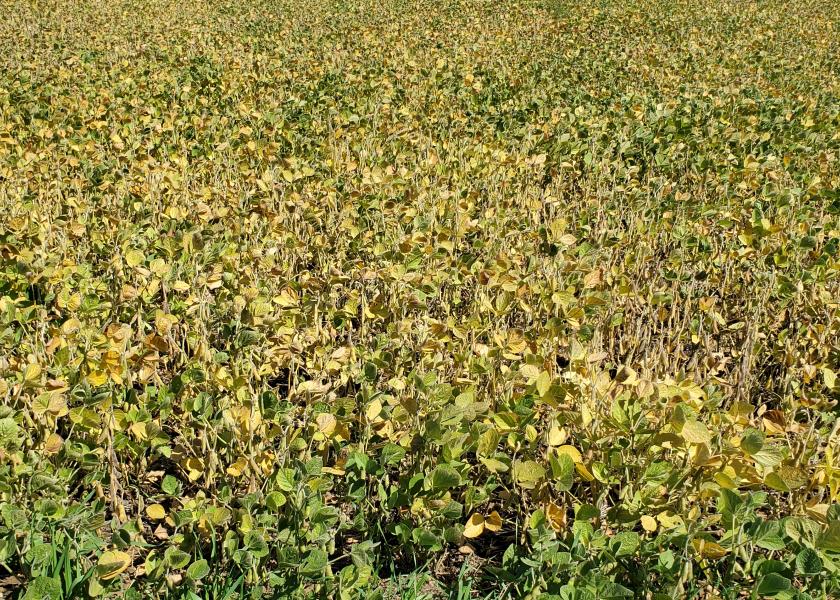Drought-stressed Soybeans Offer Forage Options

While many areas of North Dakota have received much-needed moisture recently, the ongoing drought and lack of forage options for beef producers remain.
“One potential forage source is drought-stressed soybeans that can be grazed or harvested for hay or silage,” says Janna Block, North Dakota State University (NDSU) Extension livestock systems specialist at the Hettinger Research Extension Center. “A typical expectation for yield of this crop may be around one and a half to two tons of forage per acre.”
“Before utilizing soybeans for hay or grazing, producers should consult with their crop insurance agent and local Farm Service Agency (FSA) representative to ensure that any actions to be taken will not impact insurance or farm program payments,” says Karl Hoppe, NDSU Extension livestock systems specialist at the Carrington Research Extension Center. “It also is important to check labels of herbicides that were applied to make sure there are no restrictions for livestock use.”
Forage yield and quality are affected by the stage of development. Ideally, soybeans should be harvested between R3 (beginning pod) to R5 (beginning seed) growth stage to optimize forage quality.
“Many farmers are weighing their options of using soybeans as forage now or waiting to harvest soybean seeds,” says Hans Kandel, NDSU Extension agronomist. “If the crop looks marginal but may still produce seeds, farmers can consider delaying this decision until closer to maturity. It is important to remember that forage yield and quality will continue to decline with advancing maturity.”
Pictures and descriptions of soybean growth stages can be found at www.ag.ndsu.edu/publications/crops/soybean-growth-and-management-quick-guide.
“Typically, drought-stressed soybeans will contain very few seeds,” says Kandel. “It is important to check fields for pods and pod fill to determine yield. It may be difficult to get an accurate estimate depending on the growth stage.”
For a description of estimating yield, visit www.ag.ndsu.edu/crops/soybean-articles/estimating-soybean-yields.
Mature soybean seeds typically contain around 40% crude protein and 20% oil (fat) on a dry matter basis, although these levels may be lower for drought-damaged soybeans.
“High-fat levels can negatively impact rumen microbes, reduce the digestibility of forages and may cause diarrhea and other digestive issue,” says Block. “Consumption of soybeans should be limited so that the total dietary fat level does not exceed 6% for mature cattle, typically no more than two to four pounds per head per day.”
Fencing and strip grazing may be a good option for increasing the utilization of soybeans and reducing selective grazing of pods and leaves, says Hoppe.
An accurate estimate of grain yield is critical to determine the acreage that should be available to grazing livestock daily. Nutrient analysis of standing or harvested forage is recommended due to the potential for high variation in feed quality.
“In general, research indicates that soybean forage should not make up more than 50% of the total diet,” says Hoppe. “Producers should consider this recommendation when grazing soybean fields and provide grass hay or other forage accordingly.”
“If the decision is made to graze soybeans, it is important to allow for time for livestock to adapt,” says Block. “Soybeans are a legume, and there is potential for bloat. To reduce this risk, do not turn hungry animals onto soybean fields.”
Block continues, “Provide livestock with a full feed of grass hay and turn onto pastures in the afternoon after the dew has dried. Avoid introducing livestock to soybean fields after rain. If possible, provide free-choice access to grass hay when grazing and consider the use of feed additives such as ionophores to reduce digestive issues. Animals should be closely observed during the first few days of grazing.”
Soybeans contain an enzyme that can interfere with protein digestion in pre-ruminants (nursing calves or calves under 300 pounds) or monogastrics such as swine and horses. Therefore, it is not recommended that soybeans be consumed by these classes of livestock.
Soybeans also contain urease, which breaks down urea into ammonia. This could potentially result in ammonia toxicity and death if fed at high levels. Supplements or feeds that contain urea (also referred to as non-protein nitrogen or NPN) should not be fed to cattle consuming raw soybeans.
“Soybeans also have the potential to accumulate nitrates, so forages should be screened for the presence of nitrates before consumption,” says Block.
Yield potential, stage of maturity and value of grain are important considerations when determining the best use for soybeans. There is still the potential for late-season rains, so farmers must analyze their options carefully to make the right decision for their farm/ranch.







